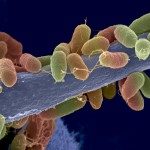Link to Pubmed [PMID] – 25560420
Mol. Microbiol. 2015 Mar;95(6):914-24
Histidine kinases (HK) sense and transduce via phosphorylation events many intra- and extracellular signals in bacteria, archaea, slime moulds and plants. HK are also widespread in the fungal kingdom, but their precise roles in the regulation of physiological processes remain largely obscure. Expanding genomic resources have recently given the opportunity to identify uncharacterised HK family members in yeasts and moulds and now allow proposing a complex classification of Basidiomycota, Ascomycota and lower fungi HK. A growing number of genetic approaches have progressively provided new insight into the role of several groups of HK in prominent fungal pathogens. In particular, a series of studies have revealed that members of group III HK, which occur in the highest number of fungal species and contain a unique N-terminus region consisting of multiple HAMP domain repeats, regulate morphogenesis and virulence in various human, plant and insect pathogenic fungi. This research field is further supported by recent shape-function studies providing clear correlation between structural properties and signalling states in group III HK. Since HK are absent in mammals, these represent interesting fungal target for the discovery of new antifungal drugs.

